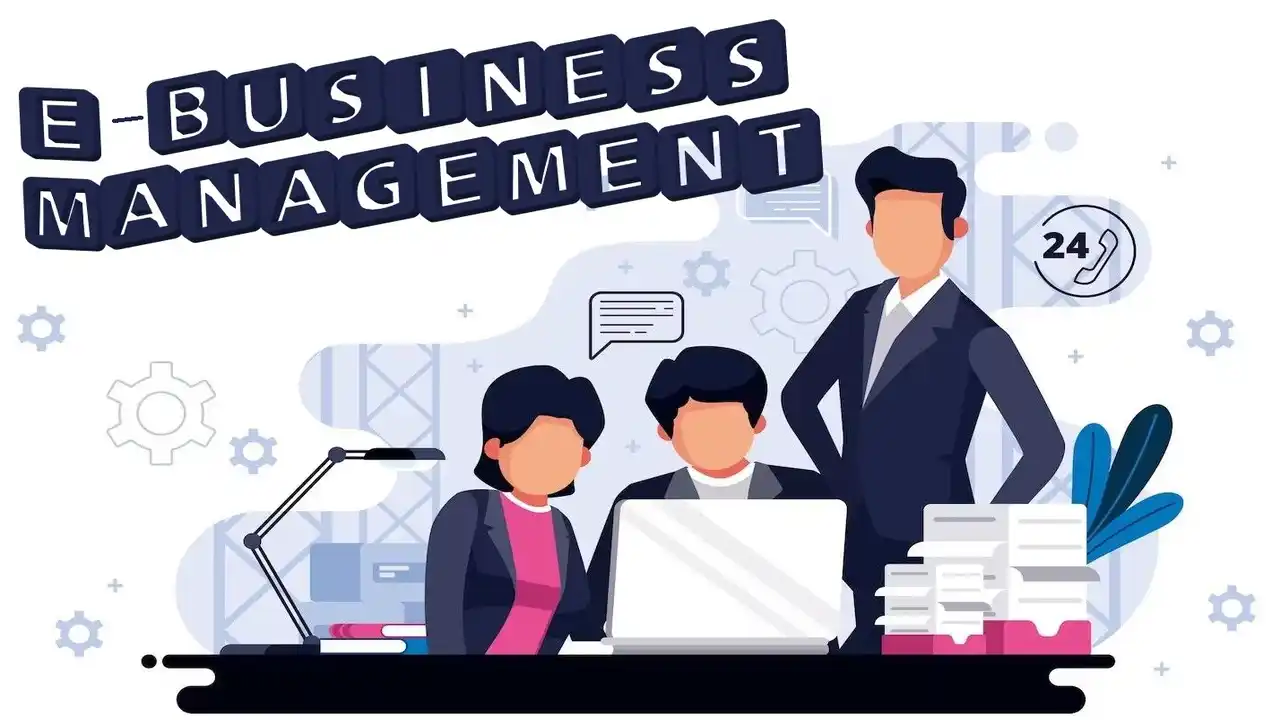Its main job is to figure out what the overall goals of your e-business brand are and then come up with a plan to reach those goals. Managing the brand’s larger team involves guiding internal recruits and managing external stakeholders to accomplish this task. We will go over the e-business management in detail in this article.
Different things, like the size of the team and the business model, can change how an online business is run, but the basics are always the same. “E-business management” is the process of keeping an eye on an online business to make sure it meets its goals for quality, growth, and customer loyalty.
E-business Management
Despite the burst of the dot-com bubble, e-commerce and e-business changes the way business is done by creating new business models and competing internationally. In today’s Internet-based economy, this course is teaching students the basics of e-business and how it works from a business perspective, which is important. This course goes over the basics of business modeling, the creation of cross-organizational processes, the analysis of e-business services, and the evaluation of technological ecosystems. Students will learn in many different ways, such as through classroom discussions, readings, case studies, group projects, and independent study. We will go over the e-business management in detail in this article. To learn about the best practices for addressing event management business plan topics, read this guide from a blog post.
Planning for Enterprise Resources
Enterprise Resource Planning (ERP) is a program that can use to reengineer a company’s production, distribution, finance, human resources, and other business processes. A comprehensive, cross-functional program, ERP. For instance, ERP software enables a business to digitally manage its needs for product availability, pricing, delivery schedules, quality assessments, and supplier price comparisons. E-business management refers to the process of overseeing the operations and strategies of a business in the digital landscape.
For achieving consumer expectations, ERP software, which is increasingly widely utilized in e-business design, is a crucial instrument. ERP improves business performance by streamlining administrative processes, which increases output, customer satisfaction, and distribution efficiency. By providing management with knowledge regarding cross-functional activities, ERP also assists management in making decisions. This information use to measure how well a business is doing.
Managing Knowledge
Many modern businesses believe that the best way to get ahead of the competition is to share knowledge and build a learning organisation. Companies must put creativity and innovation at the center of their organizational culture if they want to come up with new information, share that information with the rest of the company, and use it to make new, different products that customers will find valuable.
This is especially true in today’s economy, where technology obsolescence, fast change, and unstable markets hurt many industries. E-business management plays a crucial role in enabling businesses to stay competitive in today’s fast-paced digital economy.
Management of the Customer Lifecycle
Management of a company’s entire customer interaction cycle, from the first contact to keeping customers and adding new ones. In this section, the company focuses on the demographics of its target audience to help guide its marketing efforts. There are plans for getting customers, keeping them, and growing the business.
In this phase, called “acquisition,” the goal is to build relationships with potential new customers for as little money as possible. Part of this plan is to focus on the most valuable and likely customers. During this stage, the business thinks about how to keep its current customers. One part of this is figuring out what to sell based on what each customer wants.
Technologies for Managing what People Know
Some of the most important technologies for knowledge management are data warehousing, data mining, and portals that are made to manage and share information. Data warehousing is the process of storing all of an organization’s created and needed data in a big database.
People can get information on their own, without the help of middlemen. The old way of storing data in silos, where it couldn’t access by other departments, has been replaced by a big technological improvement known as data warehouses.
The data warehouse of a company may hold billions of bytes of information. Data mining helps people find out about things. The data mining software uses techniques for making decisions to sort through unstructured data in search of patterns and relationships that could be useful.
However, Managers can look at data about how customers buy things online to spot new market trends. Employees can access a wide range of intranet-based knowledge repositories tailored to their needs through knowledge management portals.
Taking Care of Inventory
Inventory management is the way a company takes care of its stock. Managing inventory involves ordering new supplies, storing used ones, creating space for new items, and forecasting future requirements. Strategically, it’s getting harder and harder to keep track of everything as more and more products fly off the shelves.
Also, Adding and selling new and more product categories can increase stock levels. However, a good inventory system can assist in inventory management, which is a crucial aspect of supply chain management. The key focus of e-business management is to leverage technology and the internet to optimize business processes and create new opportunities
Many small businesses make the mistake of thinking that when they hire a 3PL company to fulfil orders and store products, they also give up control of their inventory. Using a third-party logistics provider (3PL) can give a seller access to tools and information that can help them better manage their stock.
Marketing Based on Relationships
Relationship marketing directly links to the development of marketing’s growth. Standardization and mass customization are two ways that businesses often use to get economies of scale. Personal connections were the main reason for making most sales.
Because there is more competition now than there was 20 years ago, businesses need to focus on what makes them unique in order to succeed. This kind of segmentation is only possible if you know a lot about what customers want and need. So, marketing started to focus less on the public as a whole and more on each individual buyer.
Relationship marketing is based on repeat business and customer loyalty. The main goal of relationship marketing is to keep clients. Benefits of focusing on current customers: no need to pay for new ones, less price sensitivity, more referrals, higher revenue.
Management of Electronic Customer Relationships
“Electronic customer relationship management” is the process of creating ways to manage client relationships through the Internet and other digital means (or “e-CRM”).
Product
Collaboration between the sourcing manager and the buying teams is common. E-business managers provide input on product selection, web-specific product lines, and pricing strategies. Managers needn’t be logistics experts, but should stay up-to-date and optimize product delivery speed and cost. Successful e-business management requires a deep understanding of the digital landscape, including emerging trends, best practices, and potential risks.
Taking Care of E-business Application Systems
E-business leverages technology to facilitate activities such as B2B transactions and internal business processes. But technology’s huge potential can only realize if it manages well in businesses. Poor IT management leads to incompatible computer systems and software that do not work well together, making the user experience confusing.
As a result, several businesses use different kinds of software and keep their data and phone networks separate. This is not only inefficient, but it also costs a lot to keep up. These businesses cannot use technology to solve problems, make more money, or cut costs, consequently limiting their growth potential.
Frequently Asked Questions
What Kinds of Things Make up E-business?
E-business involves BI, CRM, SCM, ERP, electronic transactions, collaboration, and online business activities. E-business management involves the use of various digital tools and platforms, such as e-commerce websites, social media, and mobile apps, to engage with customers and drive sales.
What can a Business Get out of E-business Practices?
Management-focused business processes involve a variety of activities. These include buying, selling, customer service, payments, production, supply chain, partner collaboration, information sharing, employee services, and hiring.
What is Good Security for E-business?
It is impossible for data sending data warehouses are a big technological improvement over the old way of storing data, which was in silos where it couldn’t be accessed by other departments. over the network to change in any way. During transmission, it needs to safe from the pickup. Data that is being sent over the network can’t change in any way.
Conclusion
A web designer who skills in both speaking and writing is the best fit for running an online business. When running an online business, you also need to be able to solve problems and do a lot of research. Explore these e-business management tips to enhance your knowledge.







